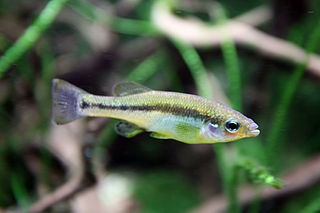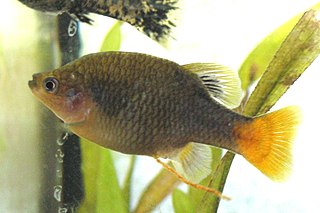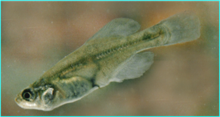
Characodon is a genus of splitfins endemic to north–central Mexico. Two of the species are highly threatened and restricted to pools, ponds and springs in the upper San Pedro Mezquital River basin in Durango. The third species, C. garmani, was restricted to springs near Parras in Coahuila, but it became extinct when they dried out.

The flavescent peacock, also known as Grant's peacock, is a species of haplochromine cichlid. Its common name refers to its "flavescent" (yellowish) colour.
Girardinichthys is a genus of splitfins that are endemic to Mexico. These highly threatened fish are native to the upper Lerma and Balsas basins, as well as water systems in the Valley of Mexico. Through man-made channels G. viviparus has been able to spread to the upper Pánuco River basin. These small fish reach up to 6.5 cm (2.6 in) in length. The name of this genus honours the American herpetologist and ichthyologist Charles Girard (1822-1895).

Goodea is a genus of splitfins that are endemic to Mexico. They are found in a wide range of habitats in several river basins that originate in the Central Plateau, such as Pánuco, Lerma–Chapala–Grande de Santiago and Balsas. Overall this genus is among the most widespread and successful splitfins, although they also have declined and the relatively restricted G. gracilis is considered vulnerable by the IUCN. This genus includes the largests splitfins, reaching a standard length of up to 20 cm (8 in). They are primarily herbivores, but also take small organisms like tiny crustaceans and snails. The is named in honour of the American ichthyologist George Brown Goode (1851-1896).

The Highland splitfin is a species of splitfin endemic to Mexico where it is found in the Lerma River basin. This species grows to a length of 5 centimetres (2.0 in) TL. It is the only known member of its genus, although some authorities have Hubbina as a subgenus of Girardinichthys and add Girardinichthys ireneae to the subgenus, even treating this taxon as a synonym of G. ireneae. This species was described by Don Fernando de Buen y Lozano in 1940 with the type locality given as Cointzio, Michoacán. The name of the genus honours the American ichthyologist Carl Leavitt Hubbs (1894-1979) while the specific name honours Clarence Lester Turner (1890-1969), thus honouring two ichthyologists who worked on a review of the Goodeidae in 1939.

The Balsas splitfin is a species of fish in the family Goodeidae. It is endemic to Mexico where it occurs in the states of Morelos and Michoacán. This fish was formally described as Goodea whitei by Seth Eugene Meek in 1904 with the type locality given as Yautepec in Morelos. The specific name honours E. A. White of the Interoceanic Railway of Mexico for his interest in and support of Meek's work.

Ilyodon is a genus of splitfins found in the Pacific slope river basins of Balsas, Tuxpan (Coahuayana), Purificación, Chacala (Marabasco), Armería and Ameca in western Mexico.
Nothobranchius robustus, the red Victoria nothobranch, is a species of killifish in the family) Nothobranchiidae. It is found in the Lake Victoria basin, the Lake Albert basin, the Sio River and near Ahero in Kenya, Tanzania, and Uganda. Its natural habitats are rivers, intermittent rivers, swamps, and intermittent freshwater marshes. This species was described in 1935 by Ernst Ahl from types collected in northwestern Tanzania.
The graceful priapella, also known by its original Spanish name guayacon ojiazul, is a species of freshwater fish within the family Poeciliidae. It is considered to be data deficient. It is endemic to a small part of central Veracruz in Mexico. It has not been recorded recently and is thought most likely to be extinct, however, the IUCN states that there is an outside chance that the species clings on in a hereto unsurveyed part of its known range and so list it as Data Deficient. The American ichthyologist Seth Eugene Meek described this fish as Gambusia bonita in 1904 with the type locality given as Río Tonto at Refugio, Veracruz, Mexico. It is the type species of the genus Priapella.
The katrana is a species of fish in the Bedotiidae family. It is endemic to the basin of Lake Alaotra in Madagascar. Its natural habitats are rivers and freshwater lakes. It is threatened by habitat loss. This species was described by Jacques Pellegrin as Atherina alaotrensis with the type locality of Lake Aloatra.
Teramulus kieneri, the Keiner's silverside or vily, is a species of silverside endemic to Madagascar where it is found in rivers around on the eastern coast. This species was described by J.L.B. Smith in 1965 with the type locality given as the coastal swamps near Tamatave. It has since been found in other areas of the island, including the basin of the Nosivolo River and in the Bemarivo River. Smith gave this species the specific name keineri to honour the French fisheries scientist, André Kiener, who assisted in the collection of the type in 1961, although it was initially reported as Atherinomorus duodecimalis. It is the type species of the genus Teramulus.

The relict splitfin is a species of splitfin endemic to the Pánuco River system in Mexico. It feeds on algae. This species grows to up to 6 centimetres (2.4 in) in length. It is found in the aquarium trade. It is the only known member of its genus.

Xenotoca is a genus of fish in the family Goodeidae from Mexico, where found in a wide range of habitats, from rivers and creeks to pools and lakes, in the Lerma–Grande de Santiago, Panuco, Cuitzeo and other basins of the Mesa Central. While no goodeid is a very common aquarium fish, the redtail splitfin, is one of the most common aquarium goodeids. Its relatively bright colors offset its reputation for being aggressive towards tankmates, occasionally even killing them. Similarly to that species, two species described in 2016 have males with red-orange tails, but this feature is not shared by the remaining members of the genus. The Xenotoca species are small, reaching up to 9 cm (4 in) in standard length.

Ctenopoma multispine, known as the many-spined ctenopoma or climbing perch, is an African freshwater fish. It is up to 14 cm (5.5 in) long and occurs in the Lufira River, Lualaba River, Upemba River, Luapula-Moero in the Democratic Republic of the Congo, Upper Zambezi in Zambia and Okavango River-Lake Ngami in Angola and Botswana. It is also known from the Kafue, rivers of coastal Mozambique, Cuanza River in Angola, and southern tributaries of the Congo River system.

Bangana is a genus of fish in the family Cyprinidae, the carps and minnows. It is distributed across much of southern and eastern Asia. Species live mainly in the flowing waters of tropical and subtropical rivers.

Chapalichthys is a genus of splitfins that are endemic to west-central Mexico, where found in lakes, pools, ponds and channels in the Lerma–Chapala–Grande de Santiago and Balsas basins. Chapalichthys reach up to 9.3 cm (3.7 in) in standard length. Despite this relatively small size, they are often caught as food in Lake Chapala.

Zoogoneticus is a genus of splitfins that are endemic to the Lerma–Chapala–Grande de Santiago, Armería, Ameca, Cuitzeo and Zacapu basins in west-central Mexico. They inhabit lakes, streams, ponds, canals and ditches, and prefer shallow waters with no or only a moderate current. They are predators that feed on small invertebrates. Zoogoneticus are fairly small fish, reaching up to 8 cm (3 in) in total length.
Belonion apodion is one of two freshwater needlefish in the genus Belonion, which is in the family Belonidae. It is native to South America where it is found in the basins of the Guaporè and Madeira Rivers. This species was described by Bruce Collette in 1966 with the type locality given as Laguna 3 kilometers southwest of Costa Marques on the Rio Guapore in Bolivia at border between Brazil and Bolivia. It is the type species of the genus Belonion.

Pseudocaranx is a genus of ray-finned fishes from the family Carangidae, the jacks, trevallies, scads and pompanos. They occurs in the western Atlantic Ocean and in the Indo-Pacific.
Oryzias dancena or the Indian ricefish are a freshwater–brackish fish species native to the India, Bangladesh, Sri Lanka, Myanmar and Thailand. Their maximum length is only 3.1 centimetres (1.2 in). They are normally found in brackish habitats near the coast, but it lives in fresh water as well. It is not considered threatened. This species was described as Cyprinus dancena by Francis Buchanan-Hamilton in 1822 with the type locality given as "Estuary below Calcutta".














